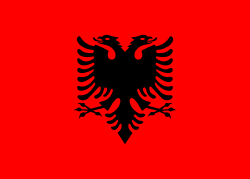
The national flag of Albania.
The national anthem of Albania.
Albania (officially the Republic of Albania, Albanian; Republika e Shqipërisë) is a Balkan country in south-eastern Europe.
Geography[]
Albania shares a border with Greece to the south/southeast, Macedonia to the east, Serbia (including Kosovo) to the northeast, and Montenegro to the northwest. Western Albania lies along the Adriatic and Ionian Sea coastlines. Albania's primary seaport is Durres, which handles 90% of its maritime cargo.
People[]
Over 90% of Albania's people are ethnic Albanian, and Albanian is the official language. Religions include Muslim (Sunni and Bektashi), Albanian Orthodox, and Roman Catholic.
Culture[]
In parts of northern Albania, families follow a code of ethics called the Kanun. This is not a religious document, but a sacred code of ethics. According to the Kanun, wealth is inherited through men, and women move to their husband's family's household when they marry. Marriages are normally arranged very early in life and women become the property of their husband's family.
The normal dress of men in Albania is usually pants and close-fitting caps. Women normally wear skirts covered by aprons. Their headgear is usually a headscarf and sometimes a veil. Albanians have an unusual way of regarding dress as a gender marker, however. Women who dress in masculine clothes are considered to be men and called virgjinesha, or 'sworn virgins'.
Under Kanun law, these virgjinesha take a vow to become a man. Once they have done this, they act like men in all respects, and are treated as men by their family and the wider community, including being referred to by masculine pronouns. However, unlike a normal man a virgjinesha never marries and preserves lifelong celibacy.
There are two reasons under Kanun law why a woman might choose to become a man. One is if she chooses not to marry a man whom her parents have chosen for her. The other is if her parents have no sons and they require her to become a ‘man’, because in Albania only men can inherit family wealth or head households.[1]
History[]
Scholars believe the Albanian people are descended from a non-Slavic, non-Turkic group of tribes known as Illyrians, who arrived in the Balkans around 2000 BC. After falling under Roman authority in 165 BC, Albania was controlled nearly continuously by a succession of foreign powers until the mid-20th century, with only brief periods of self-rule.
Following the split of the Roman Empire in 395, the Byzantine Empire established control over present-day Albania. In the 11th century, Byzantine Emperor Alexius I Comnenus made the first recorded reference to a distinct area of land known as Albania and to its people.
The Ottoman Empire ruled Albania from 1385-1912. During this time, much of the population converted to the Islamic faith, and Albanians also emigrated to Italy, Greece, Egypt and Turkey. Although its control was briefly disrupted during the 1443-78 revolt, led by Albania's national hero, Gjergj Kastrioti Skenderbeu, the Ottomans eventually reasserted their dominance.
The League of Prizren (1878) promoted the idea of an Albanian nation-state and established the modern Albanian alphabet, updating a language that survived the hundreds of years of Ottoman rule despite being outlawed. By the early 20th century, the weakened Ottoman Empire was no longer able to suppress Albanian nationalism. Following the conclusion of the First Balkan War, Albanians issued the Vlore Proclamation of November 28, 1912, declaring independence and the Great Powers established Albania's borders in 1913. Albania's territorial integrity was confirmed at the Paris Peace Conference in 1919, after U.S. President Woodrow Wilson dismissed a plan by the European powers to divide Albania among its neighbors.
During the Second World War, Albania was occupied first by Italy (1939-43) and then by Germany (1943-44). After the war, Communist Party leader Enver Hoxha, through a combination of ruthlessness and strategic alliances, managed to preserve Albania's territorial integrity during the next 40 years, but exacted a terrible price from the population, which was subjected to purges, shortages, repression of civil and political rights, a total ban on religious observance, and increased isolation. Albania adhered to a strict Stalinist philosophy, eventually withdrawing from the Warsaw Pact in 1968 and alienating its final remaining ally, China, in 1978.
Following Hoxha's death in 1985 and the subsequent fall of Communism in 1991, Albanian society struggled to overcome its historical isolation and underdevelopment. During the initial transition period, the Albanian Government sought closer ties with the West in order to improve economic conditions and introduced basic democratic reforms, including a multi-party system.
In 1992, after the sweeping electoral victory of the Democratic Party, Sali Berisha became the first democratically elected President of Albania. Berisha began a more deliberate program of economic and democratic reform but progress on these issues stalled in the mid-1990s, due to political gridlock. At the same time, unscrupulous investment companies defrauded investors all over Albania using pyramid schemes. In early 1997, several of these pyramid schemes collapsed, leaving thousands of people bankrupt, disillusioned, and angry. Armed revolts broke out across the country, leading to the near-total collapse of government authority. During this time, Albania's already inadequate and antiquated infrastructure suffered tremendous damage, as people looted public works for building materials. Weapons depots all over the country were raided. The anarchy of early 1997 alarmed the world and prompted intensive international mediation.
In 1998, Albanians ratified a new constitution via popular referendum, guaranteeing the rule of law and the protection of fundamental human rights and religious freedom.
See also[]
References[]
External links[]
| Copyright Details | |
|---|---|
| License: | This work is in the Public Domain in the United States because it is a work of the United States Federal Government under the terms of Title 17, Chapter 1, Section 105 of the U.S. Code |
| Source: | File available from the United States Federal Government. |
Source = [1]